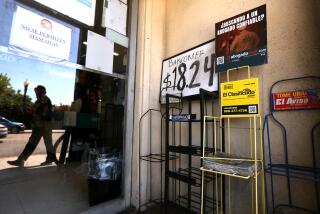Persistent Competition Colors the Market for Yellow Page Ads : Advertising: The demand for such books, particularly in Orange County, continues to grow.
- Share via
GARDEN GROVE — When Donnelley Information Publishing decided to scale back its far-flung yellow pages business, it moved its headquarters from New York to here and pulled out of every market except one: Southern California.
That decision, made in 1987, was anything but arbitrary. The Southland accounts for an estimated 10% of the $7.7 billion annually that yellow pages publishers now take in nationwide, and the local market continue to grow at a healthy clip.
Yet Donnelley was committing itself to a battle in which the chief rivals--Pacific Bell and GTE--have some very heavy artillery, and in which scrappy, second-line fighters such as United Publishers and Ross Publications have proven surprisingly durable.
And today, while the yellow pages industry is consolidating on a national level, the battle rages on in Southern California. Many in the industry consider it to be the most competitive market in the country, and Orange County--with at least three dozen separate directories--the most hotly contested piece of the region.
“Orange County is absolutely the most competitive area of all,” said David Edwards, president of Beverly Hills-based United Publishers, which was purchased in 1986 by Nynex, the huge New York-based phone company. “In the La Palma area, there are households that get 17 directories a year--and it’s hard to know which ones they keep and which ones they throw out.”
It was not so long ago that consumers--and advertisers--had no such decisions to make. Before the break-up of the AT&T; telephone monopoly in 1984, yellow pages had been a sleepy though highly profitable sideline for the phone companies, and independent publishers rarely posed a serious challenge.
But the AT&T; divestiture forced the new regional phone firms--such as Pacific Bell’s parent company, Pacific Telesis--to operate their yellow pages businesses as separate subsidiaries, revealing just how lucrative publishing classified lists of everything from restaurants to plumbers could be. Upstart entrepreneurs flocked to the business, the phone companies began to invade one anothers’ territories, and Donnelley--which for a century had been thriving as a publishing agent for some of the old AT&T; phone companies--began to publish its own directories.
Southern California proved to be especially fertile territory. Efrem Sigel, president of Communications Trends, a research and publishing firm based in Larchmont, N.Y., noted that Southern California has “a peculiar configuration of telephone company boundaries--the natural shopping areas don’t coincide with the subscriber areas.” Thus GTE and Pacific Bell, the two phone-service companies, were thrust into competition with each other, and independents could move in to exploit the fragmentation in the marketplace.
In addition, Sigel and others noted, the rapid economic growth of the area and the high mobility of the population meant that Southern Californians had a greater need for the types of services consumers normally find advertised in the yellow pages.
“It’s the best yellow pages market in the country,” said Bruce P. Takacs, director of marketing for Donnelley. “Nationally, the average person uses the yellow pages 1.86 times per week. But in California, it’s over two times.”
That explains in part why competition has persisted in the Southland even while it has been receding elsewhere. Phone companies’ efforts to invade others’ territories for the most part have proven fruitless: Southwestern Bell absorbed huge losses before it dropped an effort to penetrate yellow pages markets nationwide last year, and Nynex was forced to withdraw from neighboring territories such as New Jersey and Connecticut.
By 1987, the number of directories being published nationwide declined for the first time, as independent publishers fell victim to their own inexperience and the intensified competitive efforts of the telephone companies.
“The independents have taken a real knock in the last couple of years, especially those that have tried to compete in large markets,” Sigel noted.
But independents that developed either highly local niches or markets that target specific interest groups have survived. And although many are overmatched in trying to compete with the well-entrenched and well-financed telephone companies, some of them have substantial resources.
Donnelley, a subsidiary of Dun & Bradstreet, is one of these. After the AT&T; breakup, the company lost some of its phone company publishing contracts and decided that it had the experience and the money to compete on its own.
But Donnelly encountered some unexpectedly tough sledding, and it was forced to pull out of markets such as Houston, Tampa, Fla., and Northern California in 1987 and 1988. And while the Donnelley Directory subsidiary continues to rack up profits as an agent for Nynex and Chicago-based Ameritech, the Donnelley Information Publishing unit responsible for independent directories has had a struggle.
Since its move to Garden Grove, however, Donnelley Information has reduced its losses and is now approaching the break-even point, officials said. Dun & Bradstreet does not break out financial-results figures for the company, which employs 360 people.
Donnelley’s strategy runs counter to those normally employed by independent publishers such as United Publishers and Ross Publications, which try to beat Pacific Bell and GTE with community directories that cover very narrow geographic areas. Donnelley touts the fact that its books give broader coverage than the phone companies. Its main Orange County directory, for example, covers all of central and northern Orange County.
And Donnelley is also unique among independents in that it promotes its books heavily through advertising. The current campaign, which Takacs said is the first to jab directly at the competition, features the tag line, “The Book the Phone Company Doesn’t Want You to Read.”
“The key to our business is usage,” Takacs said by way of explaining an ad campaign aimed at consumers rather than advertisers. If people are using a certain book, he argues, then the advertisers will follow. And it doesn’t hurt that Donnelley’s rates are 30% to 60% below those of Pacific Bell (those for smaller independents are even lower).
Since the directories are distributed free to every household in a given market area, it can be hard to tell who is really using which book. Several companies, including a subsidiary of NFO Research Inc. called the National Yellow Pages Monitor, have developed a rating system for yellow pages similar to the Neilsen ratings for television, but many publishers are suspicious of the results. Pacific Bell yellow pages account for 61.1 % of all yellow page usage in Orange County, according to the Monitor, followed by GTE with 17.1% and Donnelley with 9%.
The lack of hard information on which books are being used can put the advertiser in a bind. “They are sick and tired of yellow pages costs, and every time they hear about another book, they are appalled,” said Bill Halpin of the O’Connor Agency, an Orange County advertising firm that places national yellow pages ads.
Tom Byer, owner of a roofing company in Huntington Beach that gets three-fourths of its business from the yellow pages, said the only way to deal with the proliferation of books is to “test, test, test. We ask people how they got our name. And if (a directory) doesn’t pay, you don’t do it next year.”
For all the independent directories, however, some industry officials are grousing that the telephone companies--which for many years did little more than take orders from captive advertisers--still exert undue power in the marketplace. “The Bell companies have finally stopped fighting each other, and now they’re trying to stamp out the independents,” said Alan Desser, chairman of Verified Audit Circulation, a yellow pages research firm in Marina del Rey. “They are in a position to do a lot of damage.”
Desser said the independents vastly improved the quality of all yellow pages directories with innovations such as better print quality, community service listings and local maps, which the telephone companies quickly imitated. Further, Pacific Bell and GTE have also augmented their fat, wide-area directories with smaller community books.
“Most of the major publishers are more attuned to consumer demand than in the past,” said Clint Pollard, vice president for marketing and communications at GTE Directories. “Our major competitors are Pacific Bell and Donnelley, but the smaller publishers are able to develop niche markets and do things in terms of product enhancements that are competitive, so we don’t discount them.”
And while most in the business agree that the number of printed directories is unlikely to increase in the future, neither do they predict that the competition will go away. Sigel said he foresees “a new wave of competition” driven by the development of electronic publishing.
The telephone companies are not now permitted to offer so-called electronic yellow pages--people look up listings on a personal computer or on a simple, cheap terminal--and none of the experiments under way by other companies around the country have been very successful.
But few doubt that, over time, the technology will improve and the phone companies will be permitted to take advantage of it.
In the meantime, some entrepreneurs have been successful with “talking yellow pages,” in which live or recorded listings are given over the telephone, and companies such as Donnelley are keenly interested in the possibilities.
“We’re going to see more emphasis on new product development that can make the directory more useful and more time-sensitive,” Pollard said. “And in terms of the competitive situation, we’ll continue to see intense skirmishes between GTE, Pacific Bell and Donnelley.”
And no matter what new developments emerge in the yellow pages industry, Orange County will see more of them, and sooner, than almost anywhere else.
Yellow Pages Publishers in Orange County
Here is an estimate for the shares of total yellow-pages usage and the number of directories foryellow pages publishers in Orange County. Percentages are based on data collected between mid-1959985696 Pacific Bell directories: 61.1%, 3 books All others: 4.4%, 10 books United Publishers: 2.2%, 7 books Ross Publications; 2.6% , 2 books Donnelley Information Publishing: 9%, 2 books GTE directories; 17.1%, 9 books Hot Topics in Orange County Here are the subject headings consulted most often by users of yellow pages in Orange County. 1. Restaurants 2. Auto parts 3. Auto repair 4. Lawn and garden equipment 5. Banks and savings and loans 6. Government offices and agencies 7. Physicians and surgeons 9. Pizza 10. Hardware Source: National Yellow Pages Monitor
More to Read
Inside the business of entertainment
The Wide Shot brings you news, analysis and insights on everything from streaming wars to production — and what it all means for the future.
You may occasionally receive promotional content from the Los Angeles Times.










